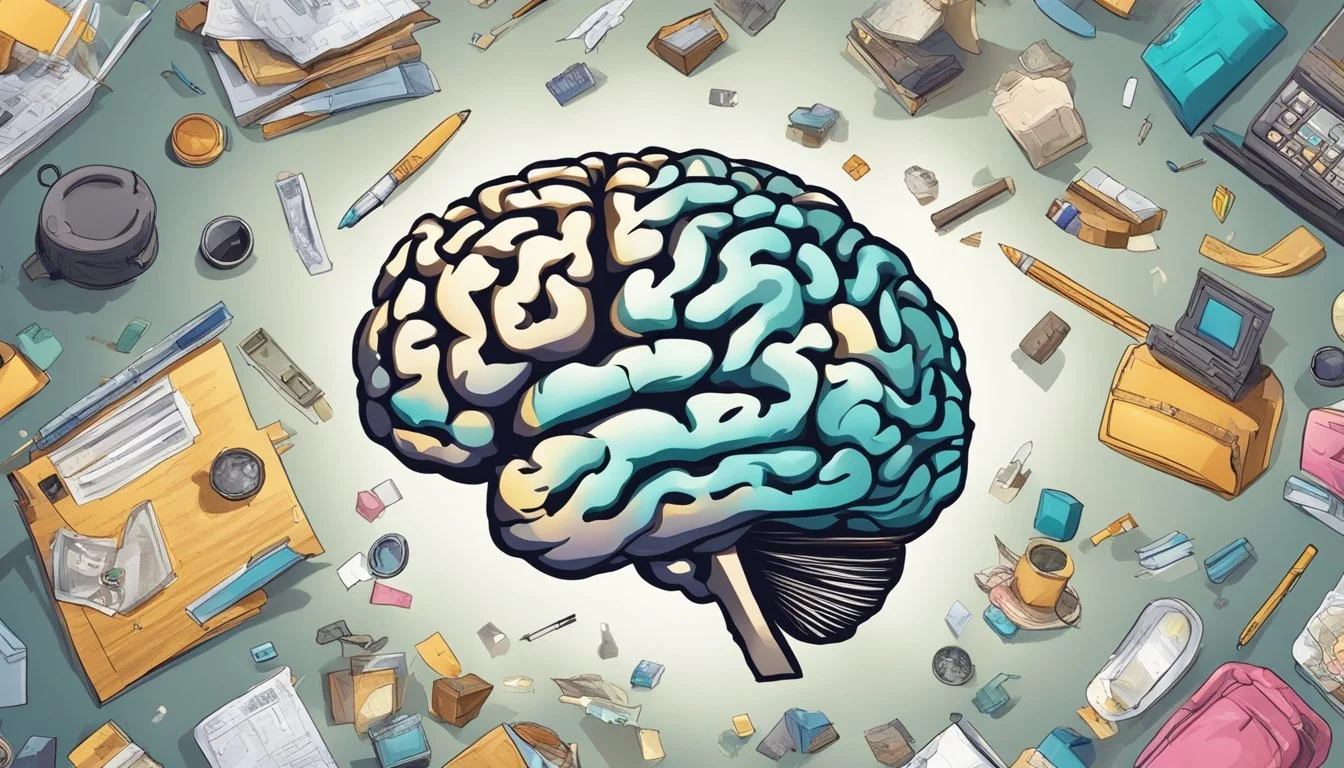Hoarding Disorder and Its Relationship to Brain Damage
Hoarding disorder is a complex mental health condition characterized by difficulty discarding possessions and excessive acquisition of items. While the exact causes remain unclear, researchers have been investigating potential links between hoarding behaviors and brain function.
Studies have found distinct brain activity patterns in individuals with hoarding disorder, particularly in regions involved in decision-making and emotional processing. Neuroimaging research has revealed under-activation in certain brain areas when hoarders interact with others' possessions, but over-activation when deciding whether to keep or discard their own items. These findings provide valuable insights into the neurological underpinnings of hoarding behaviors.
Brain injuries have also been identified as a potential risk factor for developing hoarding disorder. Trauma to specific brain regions, such as the prefrontal cortex, may contribute to difficulties with decision-making, impulse control, and emotional regulation - all of which play a role in hoarding behaviors. Understanding these connections between brain function and hoarding tendencies could lead to more effective treatment strategies for those struggling with this challenging condition.
Understanding Hoarding Disorder
Hoarding disorder is a complex psychiatric condition characterized by persistent difficulty discarding possessions, regardless of their actual value. It can lead to significant impairment in daily functioning and create unsafe living conditions.
Definition and Classification
Hoarding disorder is classified as a distinct mental health condition in the Diagnostic and Statistical Manual of Mental Disorders, Fifth Edition (DSM-5). It is characterized by a persistent difficulty parting with possessions, regardless of their actual value. This difficulty stems from a perceived need to save items and distress associated with discarding them.
The disorder results in the accumulation of a large number of possessions that clutter living areas, making them unusable for their intended purpose. Hoarding disorder is no longer considered a subtype of Obsessive-Compulsive Disorder (OCD), although they share some similarities.
Symptoms and Behaviors
Key symptoms of hoarding disorder include:
Difficulty discarding or parting with possessions
Strong urges to save items and distress when attempting to discard them
Excessive acquisition of unnecessary items
Cluttered living spaces that prevent normal use of rooms and furniture
These behaviors often lead to significant distress and impairment in social, occupational, or other important areas of functioning. Individuals with hoarding disorder may experience anxiety, avoidance behaviors, and difficulty making decisions about their possessions.
Safety concerns can arise from cluttered living spaces, including fire hazards, tripping hazards, and unsanitary conditions.
Prevalence and Demographics
Hoarding disorder affects approximately 2-6% of the general population. It typically begins in childhood or adolescence but often goes unrecognized until adulthood. The disorder tends to worsen with age, with symptoms becoming more severe in older adults.
Hoarding appears to affect men and women equally. Family history may play a role, as individuals with first-degree relatives who hoard are more likely to develop the disorder themselves.
Comorbidity with other mental health conditions is common. Many individuals with hoarding disorder also experience depression, anxiety disorders, or attention-deficit/hyperactivity disorder (ADHD).
Etiology of Hoarding Disorder
Hoarding disorder arises from a complex interplay of genetic, psychological, and environmental factors. Research has identified several key influences that contribute to the development and persistence of hoarding behaviors.
Genetic and Family Influences
Studies suggest a strong genetic component in hoarding disorder. Twin studies have shown higher concordance rates in identical twins compared to fraternal twins. Researchers estimate that genetic factors account for approximately 50% of the variance in hoarding symptoms.
Family history also plays a role. Individuals with hoarding disorder are more likely to have first-degree relatives who exhibit similar behaviors. This familial pattern suggests both genetic and environmental contributions.
Specific genes linked to hoarding tendencies are still being investigated. Some research points to variations in genes involved in neurotransmitter systems, particularly serotonin and dopamine pathways.
Psychological Factors
Cognitive-behavioral models highlight several psychological factors in hoarding disorder. Individuals often exhibit difficulties with decision-making, emotional attachment to objects, and beliefs about possessions.
Many hoarders struggle with information processing and categorization. They may have trouble organizing items and deciding what to keep or discard. This indecisiveness can lead to accumulation over time.
Emotional attachment to objects is another key factor. Hoarders often ascribe special meaning or value to possessions, making it challenging to part with them. This attachment may stem from underlying issues with emotional regulation or interpersonal relationships.
Beliefs about the importance of saving and fears of wasting also contribute. Hoarders may believe they need items for future use or feel responsible for preserving objects.
Trauma and Stressful Life Events
Traumatic experiences and stressful life events can trigger or exacerbate hoarding behaviors. Loss of a loved one, divorce, job loss, or other significant changes may lead some individuals to seek comfort in acquiring and keeping possessions.
Childhood trauma, such as abuse or neglect, has been linked to hoarding tendencies in adulthood. These early experiences may contribute to attachment issues and difficulty regulating emotions.
Chronic stress can also play a role. Some individuals may turn to collecting or saving items as a coping mechanism for ongoing anxiety or depression. The act of acquiring may provide temporary relief or a sense of control.
Neurobiological Perspective
Hoarding disorder involves complex neurobiological underpinnings affecting brain function, cognitive processes, and neural activity patterns. Research has uncovered key insights into the disorder's neurological basis.
Brain Function and Structure
The prefrontal cortex plays a crucial role in hoarding disorder. This region, responsible for executive functions like decision-making and impulse control, shows altered activity in individuals with hoarding tendencies.
The anterior cingulate cortex and insula also exhibit abnormal functioning. These areas are involved in emotional regulation and interoceptive awareness, potentially contributing to the intense distress hoarders experience when discarding possessions.
Structural brain differences have been observed in some studies. Variations in gray matter volume and white matter integrity may influence information processing and cognitive flexibility in hoarding disorder.
Neuropsychology and Cognitive Processes
Cognitive impairments are common in hoarding disorder. Difficulties with executive functioning, including problems with planning, organization, and decision-making, are frequently observed.
Visual memory deficits may contribute to excessive acquisition behaviors. Individuals with hoarding disorder often struggle to mentally categorize and organize items effectively.
Impaired information processing can lead to difficulty in assessing the value or utility of possessions. This cognitive pattern may reinforce the accumulation of objects and resistance to discarding.
Attention deficits and problems with sustained focus are also notable. These issues can interfere with sorting and organizing belongings, exacerbating clutter.
Functional Imaging Studies
Functional magnetic resonance imaging (fMRI) studies have provided valuable insights into hoarding disorder. Brain scans reveal distinct patterns of neural activity during decision-making tasks related to possessions.
When deciding whether to discard personal items, individuals with hoarding disorder show heightened activity in regions associated with emotional attachment and decision conflict. The anterior cingulate cortex and insula often display increased activation.
Conversely, under-activation in the prefrontal cortex is observed during these tasks. This pattern may reflect impaired cognitive control and difficulty in overriding emotional attachments to objects.
Neuroimaging has also revealed altered activity in reward circuitry. This finding suggests that acquiring and keeping possessions may activate pleasure centers in the brains of individuals with hoarding disorder.
Impact on Quality of Life
Hoarding disorder significantly affects multiple aspects of an individual's life, creating unsafe living conditions and straining relationships with family and friends.
Living Conditions and Safety
Excessive clutter in homes of those with hoarding disorder poses serious safety risks. Piles of items can block exits, increasing fire hazards and impeding emergency responders. Accumulated possessions may lead to unsanitary conditions, attracting pests and creating health risks.
Clutter on floors and furniture increases the likelihood of falls, especially for older individuals. Blocked pathways make it difficult to move around the home safely. In severe cases, structural damage can occur due to the weight of hoarded items.
Emotional and Social Consequences
Hoarding disorder often leads to feelings of shame, depression, and loneliness. Individuals may avoid inviting others to their homes due to embarrassment about the clutter. This can result in social isolation and withdrawal from relationships.
The emotional attachment to possessions can cause distress when attempting to discard items. This struggle may lead to anxiety and low self-esteem. The disorder's impact on daily functioning can further contribute to a decreased sense of well-being and quality of life.
Family and Friends
Relationships with family and friends are frequently strained by hoarding behaviors. Loved ones may feel frustrated or helpless when attempts to help are met with resistance. Disagreements about clutter and safety concerns can lead to conflict and damaged relationships.
Family members living in the same household may experience stress and embarrassment. Children growing up in cluttered environments may face social and developmental challenges. In some cases, the extent of hoarding can lead to legal issues, such as eviction or loss of child custody.
Approaches to Treatment
Effective treatment for hoarding disorder involves a multifaceted approach targeting cognitive, behavioral, and organizational aspects. Evidence-based interventions aim to address underlying thought patterns, modify behaviors, and develop practical skills for managing possessions.
Cognitive-Behavioral Therapy
Cognitive-behavioral therapy (CBT) is the primary psychotherapeutic intervention for hoarding disorder. It focuses on challenging and modifying dysfunctional beliefs about possessions. Therapists help patients identify and restructure thoughts that contribute to excessive acquisition and difficulty discarding items.
CBT for hoarding typically includes exposure exercises, where individuals gradually face the anxiety of discarding or not acquiring items. Patients learn to tolerate discomfort and develop more adaptive coping strategies.
Skills training is a crucial component, teaching organizational techniques and decision-making processes for sorting and discarding. Therapists may conduct home visits to provide in-vivo guidance and support.
Group CBT formats have shown promise, offering peer support and shared learning experiences.
Pharmacotherapy
Medication can play a supportive role in treating hoarding disorder, particularly when comorbid conditions are present. Selective serotonin reuptake inhibitors (SSRIs) are the most commonly prescribed class of medications.
SSRIs may help reduce anxiety and depressive symptoms often associated with hoarding. They can also potentially decrease the urge to acquire new items.
Other medications, such as stimulants or antipsychotics, might be considered in specific cases, especially when attention deficits or thought disorders are present.
Pharmacotherapy is typically used in conjunction with psychotherapy rather than as a standalone treatment.
Organizational and Decluttering Strategies
Practical interventions focus on developing organizational skills and implementing decluttering techniques. Professional organizers or coaches may work alongside mental health professionals to provide hands-on assistance.
Strategies often include:
Creating a sorting system (keep, donate, discard)
Establishing designated storage areas
Implementing the "one in, one out" rule
Setting specific goals for reducing clutter
Digital tools and apps can help track progress and maintain motivation. Some individuals benefit from joining support groups or workshops focused on organization and decluttering.
Regular follow-up sessions help reinforce newly acquired habits and prevent relapse. Involving family members or friends can provide additional support and accountability in maintaining an organized living space.
Navigating Professional Help
Seeking professional assistance is crucial for effectively managing hoarding disorder. A comprehensive approach involving diagnosis, support, and education can lead to better outcomes for individuals struggling with this condition.
Diagnostic Process
Mental health providers play a key role in diagnosing hoarding disorder. They conduct clinical assessments to evaluate the severity of symptoms and their impact on daily functioning. These assessments often include interviews, questionnaires, and home visits when possible.
Health care providers may also check for underlying medical conditions that could contribute to hoarding behaviors. This may involve physical exams and laboratory tests to rule out neurological issues or other health concerns.
A thorough diagnostic process helps distinguish hoarding disorder from other psychiatric disorders with similar symptoms, such as obsessive-compulsive disorder or depression.
Building a Support System
Creating a strong support network is essential for individuals with hoarding disorder. Mental health professionals can help patients identify and engage trusted family members, friends, or community resources.
Support groups offer valuable opportunities for individuals to connect with others facing similar challenges. These groups provide a safe space to share experiences, coping strategies, and encouragement.
Professional organizers or clutter coaches may be part of the support system, offering practical assistance in decluttering and organizing living spaces. Their expertise can complement therapeutic interventions and help maintain progress.
Preventative Measures and Education
Education plays a vital role in preventing hoarding behaviors from escalating. Mental health providers offer psychoeducation to patients and their families, explaining the nature of hoarding disorder and its potential consequences.
Cognitive-behavioral therapy techniques can be taught as preventative measures. These may include strategies for decision-making, organizing, and managing emotional attachments to possessions.
Awareness campaigns in schools and communities can help identify early signs of hoarding tendencies. Early intervention and support can prevent the development of more severe hoarding behaviors later in life.
Public health initiatives focused on mental health literacy can reduce stigma and encourage individuals to seek help before hoarding becomes unmanageable.






